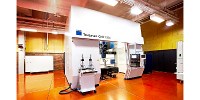Researchers have used sound vibrations to shake metal alloy grains into the tighter formation during 3D printing.
A new study shows high-frequency sound waves can have a significant impact on the inner microstructure of 3D printed alloys, making them more consistent and stronger than those printed conventionally.
Lead author and Ph.D. candidate from RMIT University’s School of Engineering, Carmelo Todaro, said the promising results could inspire new forms of additive manufacturing.
Testing showed these parts were also stronger: they had a 12% improvement in tensile strength and yield stress compared to those made through conventional additive manufacturing.
The team demonstrated their ultrasound approach using two major commercial grade alloys: a titanium alloy commonly used for aircraft parts and biomechanical implants, known as Ti-6Al-4V, and a nickel-based superalloy often used in marine and petroleum industries called Inconel 625.
By simply switching the ultrasonic generator on and off during printing, the team also showed how specific parts of a 3D printed object can be made with different microscopic structures and compositions, useful for what’s known as functional grading.
Study co-author and project supervisor, RMIT’s Distinguished Professor Ma Qian, said he hoped their promising results would spark interest in specially designed ultrasound devices for metal 3D printing.
This research was conducted at RMIT University’s Advanced Manufacturing Precinct and supported by an Australian Research Council Discovery Project grant.


